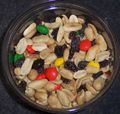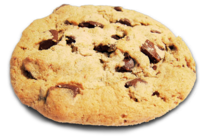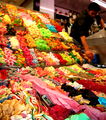Snack food
 |
| Part of the Meals series |
| Common meals |
| Breakfast · Brunch · Lunch · Tea · Dinner · Supper |
| Components & courses |
| Amuse-bouche · Appetizer · Cheese · Dessert · Drink · Entrée · Entremet · Fruit · Main course · Nuts · Salad · Side dish |
| Related concepts |
| Banquet · Buffet · Cuisine · Eating · Etiquette · Food |
A snack food (commonly called a snack) is seen in Western culture as a type of food not meant to be eaten as a main meal of the day – breakfast, lunch, or dinner – but rather to assuage a person's hunger between these meals, providing a brief supply of energy for the body. The term may also refer to a food item consumed between meals purely for the enjoyment of its taste.
Traditionally snacks were prepared from ingredients commonly available in the home, often leftovers, sandwiches made from cold cuts, nuts, fruit, and the like. The Dagwood sandwich was originally the humorous result of a cartoon character's desire for large snacks. Beverages are not considered real snacks, especially coffee. The only instance in which a beverage constitutes a snack is if it possesses a substantive food item (e.g., strawberries, bananas, kiwis) and then blended to create a smoothie.
With the spread of convenience stores, packaged snack foods are now a significant business. Snack foods are typically designed to be portable, quick and satisfying. Processed snack foods are designed to be less perishable, more durable, and more appealing than prepared foods. They often contain substantial amounts of sweeteners, preservatives, and appealing ingredients such as chocolate, peanuts, and specially-designed flavors (such as flavored potato chips). A snack eaten shortly before going to bed or during the night may be called a midnight snack.
Contents |
Nutritional concerns
Snack foods are often subjectively classified as junk food because they typically have little or no nutritional value, and are not seen as contributing towards general health and nutrition. With growing concerns for diet, weight control and general health, government bodies like Health Canada[1] are recommending that people make a conscious effort to eat more healthy, natural snacks – such as fruit, vegetables, nuts and cereal grains – while avoiding high-calorie, low-nutrient junk food.
A 2010 study showed that children in the United States snacked on average six times per day, approximately twice as often as American children in the 1970s.[2]
Industry concerns
The snack food industry in market-driven societies such as the United States generates billions of dollars in revenue each year. The market for processed snack foods is enormous, and a number of large corporations compete rigorously to capture larger shares of the snack food market. Consequently, heavy promotions are used to convince consumers to buy snack foods. Processed snack foods are advertised far more than regular nutritional foods (such as fruit, vegetables, meat, dairy products), and the flashiest TV commercials and advertising campaigns are often designed to sell these products.
However, realizing the potential market discovered by companies such as Hansen's Natural, companies like Frito-Lay, PepsiCo, Coca-Cola and Santangelo Mckiplinger, LLC are now creating new alternatives for consumers.
Types of snack foods
- Almonds
- Cheese puffs/Cheese curls
- Cheese
- Corn chips and Tortilla chips
- Crackers
- Cookies/Biscuits
- Doughnuts
- Dried fruit
- Granola bars
- Sliced fruit
- Vegetables (e.g. carrots, cherry tomatoes)
- Instant noodles
- Jerky
- Mixed nuts
- Peanuts
- Popcorn
- Pork rinds
- Potato chips
- Pretzels
- Raisins
- Seeds (sunflower)
- Trail mix
- Whole fruit
Gallery
 Trail mix |
 A small cheese flavored cracker of the Cheez-It brand |
||
 A candy bar of the Twix brand |
 Chocolate chip cookie |
||
 Fried cheese flavored snacks, the Cheetos brand |
 Ants on a log |
 Twisties, extruded snack from corn and rice |
See also
- Canapés
- List of snack foods



